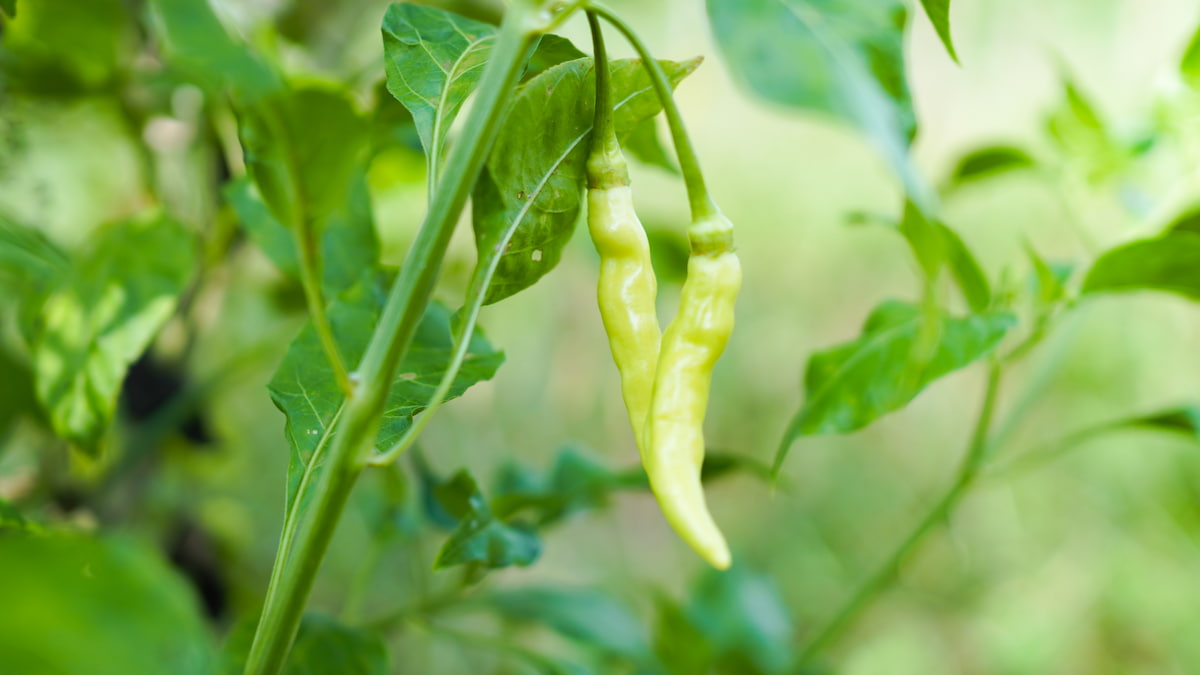The Chilli Whitefly, Bemisia tabaci, belonging to the Family Aleyrodidae of the Order Hemiptera, is a notorious pest that causes significant yield losses and reduces the quality of crops worldwide. It is also known as Silverleaf Whitefly or Sweet Potato Whitefly. The chilli whitefly is a sap-sucking insect that feeds on the phloem sap of the chilli plant, causing it to weaken, wilt, and eventually die.

The chilli whitefly is known to transmit several viruses, like, Tomato yellow leaf curl virus and Pepper golden mosaic virus, that can cause severe damage to chilli crops. These viruses can lead to stunted growth, yellowing of leaves, and reduced yields. To effectively manage this pest, it is essential to understand its life cycle, its preferred habitats, and the best methods for controlling it. This article will provide an overview and discussion of the Chilli Whitefly Pest in Chilli crops, including its symptoms, identification techniques, and control.
Whitefly Pest Management in Chilli
Life Cycle of Chilli Whitefly Pest in Chilli Crop
The life cycle of the Chilli Whitefly pest has four stages. They are egg, nymph, pupa, and adult. The life cycle begins when the female chilli whitefly lays eggs on the underside of the leaves. Depending on temperature and humidity, they are usually laid in circular or irregular patterns and take around 5-10 days to hatch.
After hatching, the eggs develop into nymphs. They feed on the plant sap by inserting their mouthparts into the leaf tissue. The nymphs go through four instars, shedding their skin between each instar. The duration of the nymphal stage varies between 7-14 days, depending on temperature and humidity. After the fourth instar, the nymphs moult into pupae, which are immobile and enclosed in a waxy, protective covering called a puparium.
The pupal stage lasts approximately 4-5 days before emerging as adult whiteflies. The adults are capable of flight and can disperse to other plants or even other fields. The adults mate soon after emergence, and the females begin laying eggs, starting the life cycle again. The entire life cycle of chilli whiteflies, from egg to adult, can take anywhere from 20-30 days.
Occurrence of Chilli Whitefly Pest in Chilli Crop
- Location of Chilli Whitefly Pest: This pest infests Chilli crops in India, Bangladesh, Nepal, Africa, Sri Lanka, China, Thailand, Malaysia, Vietnam, Indonesia, the United States, Mexico, Brazil, Colombia, Ecuador, the Philippines, New Zealand, and Australia.
- Host Range: The Chilli Whitefly pest infects crops like Chilli, Tomato, Brinjal, Cotton, Citrus, Poinsettia, Hibiscus, Cucumber, Squash, Pumpkin, and Sweet Potato.
Factors Favoring the Population Increase of Chilli Whitefly Pest in Chilli Crop
- Temperature – The pest prefers warm temperatures between 25°C to 30°C. In areas with warm temperatures, the pest can reproduce quickly.
- High Humidity – The pest can absorb moisture from the air, and high humidity levels provide the ideal conditions for the pest to thrive and reproduce.
- Low Light Intensity – The pest prefers low light intensity, and shaded areas are favourable for their survival and reproduction.
- Poor Plant Nutrition – Plants that are stressed or have poor nutrition are more susceptible.
- Lack of Natural Enemies – Pest populations can quickly multiply in areas with few natural enemies.
- Monoculture – The pest can quickly move from plant to plant and can lead to the build-up of pest populations.
Identification of Chilli Whitefly Pest in Chilli Crop
- Egg: The eggs are small, white or pale yellow, oval-shaped, and approximately 0.2mm long.
- Nymph: The nymphs are small, pale yellow, wingless, oval-shaped, and have a distinct, dark eye spot.
- Adult: The adults are small, white insects with four wings covered in powdery wax. The female adult is larger than the male and has longer wings.
In case you missed it: Chilli Thrips Management: Symptoms, Treatment, Chemical, Biological, and Organic Control

Damage Symptoms of Chilli Whitefly Pest in Chilli Crop
- The chilli whitefly feeds on the plant’s sap from the phloem tissues, which causes the yellowing and wilting of plants.
- The nymphs and adults excrete a honeydew-like sticky substance, which can encourage the growth of sooty mould.
- The sooty mould covers the leaf resembling a sick appearance.
- This reduces the photosynthetic activity of the plants by
- They act as vectors and transmit viruses like Leaf curl, Gemini, and Mosaic viruses from one plant to another.
Percentage of Yield Loss in Chillis Due to Chilli Whitefly Pest
- In India, the yield losses due to Chilli Whitefly pests are 20-40%. In Bangladesh, the losses are 30%. In Nepal, the losses are 50%. In Thailand, the yield loss is 50%. In Malaysia, it is 70%. In Vietnam, the losses are 40%. In Sri Lanka, the losses are 50%. In Indonesia, the losses are 70%. In Africa, it is 20-60%. In the United States, it is 50%. In Mexico, it is 50%. In Brazil, it is 60%. In China, it is 60%.
- In Colombia, the losses are 50%. In Ecuador, it is 40%. In New Zealand, it is 30%. In Australia, it is 50%. In the Philippines, the yield losses are 60%. The Economic Threshold Level (ETL) for the Chilli Whitefly pest is set at 10-20 nymphs per leaf.
Cultural Control of Chilli Whitefly Pest in Chilli Crop
- Crop Rotation – Planting different crops in a field in successive seasons can help reduce pest population build-up.
- Plant Density – Increasing the spacing between plants can improve airflow and reduce humidity, making the environment less favourable for the pest.
- Sanitation – Regular removal of plant debris and weeds can help to reduce the availability of host plants and breeding sites for the pest.
- Mulching – Mulch can help reduce moisture levels in the soil and prevent weed growth, which can serve as an alternative host for the pest.
- Irrigation – Over-watering can increase humidity, while under-watering can weaken plants and make them more susceptible.
- Trap-Cropping – This involves planting crops attractive to the pest, such as sunflowers or beans, around the perimeter of the chilli crop.
Biological Control of Chilli Whitefly Pest in Chilli Crop
- Encarsia formosa – This parasitic wasp lays its eggs inside the pest’s nymphs, which hatch into larvae that consume the host from the inside out.
- Eretmocerus mundus – This parasitic wasp lays its eggs inside the pest’s nymphs, causing them to die before adulthood.
- Ladybirds – Ladybirds, also known as ladybugs, are voracious predators, and they feed on both the eggs and nymphs of the pest.
- Lacewings – They are effective predators and feed on the pest’s eggs and nymphs.
- Predatory mites – Predatory mites, such as Neoseiulus californicus, feed on the pest’s eggs.
Chemical Control of Chilli Whitefly Pest in Chilli Crop
- Spray insecticides like, Methyl demeton, Ethion, Acetamiprid, Imidacloprid, Diafenthiuron, and Acephate on the foliage to control the pest.
- Apply Triazophos or Prophanophos on the affected area to minimize the impact.
Organic Control of Chilli Whitefly Pest in Chilli Crop
- Spray Neem Seed Kernel Extract or Fish oil rosin soap to control the pest.
- Apply Vermicompost obtained by composting organic waste by earthworms to control the pest.
- Plant extracts from neem, garlic, tobacco, cinnamon, ginger, turmeric, hot pepper, and Chilli can be applied to manage the infestation.
- Beauveria bassiana can be applied as a biopesticide to infect and kill the pest.
Preventive Measures for Control of Chilli Whitefly Pest in Chilli Crop
- Sticky Traps – Use yellow sticky traps with grease and sticky oils to control the pest.
- Pheromone Traps – Pheromone traps can help monitor the pest population and determine the timing of insecticide applications.
- Resistant Varieties – Use chilli varieties that are resistant or tolerant to pests to reduce the risk of infestation and minimize crop damage.
- Physical Barriers – Covering chilli plants with physical barriers such as insect-proof nets can prevent the pest from accessing the crop.
- Early Planting – Planting chilli crops early in the season can allow the plants to grow and establish before the arrival of the pest.
- Monitoring – Monitor the crops regularly to identify pest infestation in the early stages to keep it under control.
In case you missed it: Chilli Cutworm Pest Management: Symptoms, Treatment, Chemical, Biological, and Organic Control

Conclusion
The Chilli Whitefly Pest, Bemisia tabaci, is a major pest that affects Chilli production worldwide, causing significant yield losses and economic damage. Integrated pest management approaches offer effective and sustainable strategies for managing this pest by combining multiple control tactics, including cultural, biological, and chemical control measures.
- Beneficial Insects in Pest Management
- Natural Solutions for Pest Control in Flower Gardens
- Types of Fungicides Used in Agriculture
- Common Issues in the Fruit Development Stage of Pomegranate Farming
- Fruit Development Issues in Papaya: Easy Solutions and Treatment
- Soil-Borne Diseases and How to Protect Your Plants
- Practices to Prevent Disease Spread in the Garden
- From Wilted to Thriving: How to Treat Root Rot Naturally in Houseplants
- Natural Remedies to Cure Brown Spots on Fig Tree Leaves